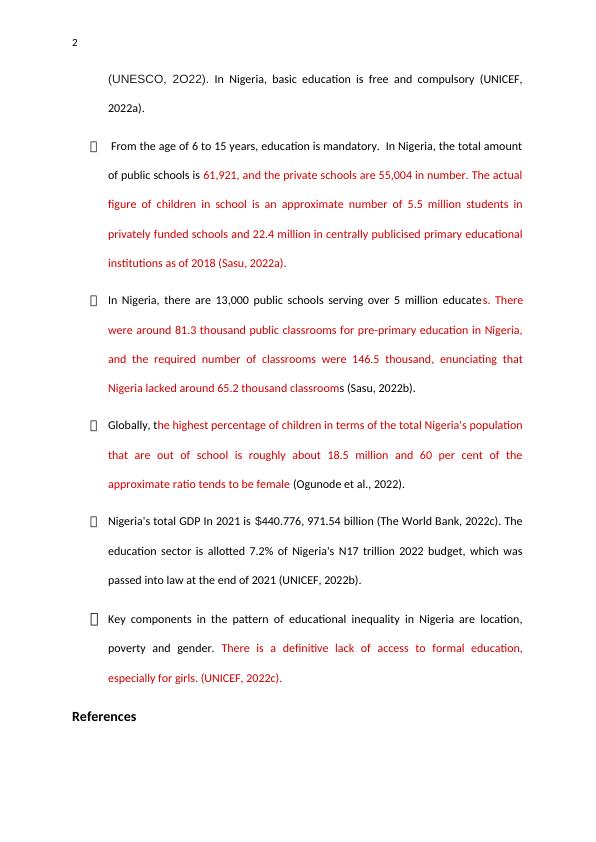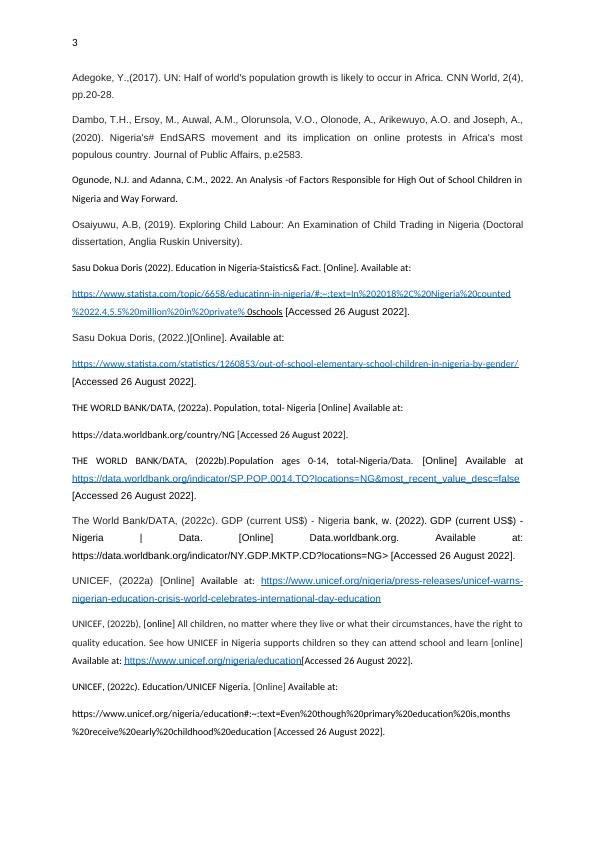Education for Children and Young People in Nigeria and the United Kingdom
8 Pages1991 Words102 Views
Added on 2023-06-07
About This Document
This article provides a fact sheet on education for children and young people in Nigeria and the United Kingdom. It covers the education system, compulsory education, number of schools, literacy rates, GDP, and government spending on education.
Education for Children and Young People in Nigeria and the United Kingdom
Added on 2023-06-07
ShareRelated Documents
1
0
FACT SHEET I
Fact sheet on education for children and young people in Nigeria
Nigeria is located in West Africa and is the most populated nation of the country. In
terms of the compass of population, Nigeria ranks seventh on an international level
(Adegoke, 2017; Dambo et al., 2020). Nigeria is home to thousands of multi-ethnic
communities that speak various languages and adhere to various religions; in 1991, Nigeria
signed the UN'S group meeting in regards to the children's rights (Osaiyuwu, 2019). Nigeria
is categorized as a lower middle-income nation, with an estimated population of 211,
400,704 million people in 2021(The World Bank, 2022a).
The total number of children in Nigeria from the years 0 to 14 is estimated to be
91,555,124 million, with 46,806,974 males and 44,748,139 females in 2021 (The
World Bank, 2022b).
The education system in Nigeria is structured using the formula of 1 year time period
of pre-primary schooling, 3 years of junior-grade and then the school from
elementary pedagogy. The very next 3 years are precedent secondary and followed
by 4 years of university teaching. (Ogunode et al. 2022).
9 years of formal education is compulsory for the attainment of basic pedagogy in
the country, as per the instructions of the National Policy on Education, 2004
0
FACT SHEET I
Fact sheet on education for children and young people in Nigeria
Nigeria is located in West Africa and is the most populated nation of the country. In
terms of the compass of population, Nigeria ranks seventh on an international level
(Adegoke, 2017; Dambo et al., 2020). Nigeria is home to thousands of multi-ethnic
communities that speak various languages and adhere to various religions; in 1991, Nigeria
signed the UN'S group meeting in regards to the children's rights (Osaiyuwu, 2019). Nigeria
is categorized as a lower middle-income nation, with an estimated population of 211,
400,704 million people in 2021(The World Bank, 2022a).
The total number of children in Nigeria from the years 0 to 14 is estimated to be
91,555,124 million, with 46,806,974 males and 44,748,139 females in 2021 (The
World Bank, 2022b).
The education system in Nigeria is structured using the formula of 1 year time period
of pre-primary schooling, 3 years of junior-grade and then the school from
elementary pedagogy. The very next 3 years are precedent secondary and followed
by 4 years of university teaching. (Ogunode et al. 2022).
9 years of formal education is compulsory for the attainment of basic pedagogy in
the country, as per the instructions of the National Policy on Education, 2004

2
(UNESCO, 2O22). In Nigeria, basic education is free and compulsory (UNICEF,
2022a).
From the age of 6 to 15 years, education is mandatory. In Nigeria, the total amount
of public schools is 61,921, and the private schools are 55,004 in number. The actual
figure of children in school is an approximate number of 5.5 million students in
privately funded schools and 22.4 million in centrally publicised primary educational
institutions as of 2018 (Sasu, 2022a).
In Nigeria, there are 13,000 public schools serving over 5 million educates. There
were around 81.3 thousand public classrooms for pre-primary education in Nigeria,
and the required number of classrooms were 146.5 thousand, enunciating that
Nigeria lacked around 65.2 thousand classrooms (Sasu, 2022b).
Globally, the highest percentage of children in terms of the total Nigeria's population
that are out of school is roughly about 18.5 million and 60 per cent of the
approximate ratio tends to be female (Ogunode et al., 2022).
Nigeria's total GDP In 2021 is $440.776, 971.54 billion (The World Bank, 2022c). The
education sector is allotted 7.2% of Nigeria's N17 trillion 2022 budget, which was
passed into law at the end of 2021 (UNICEF, 2022b).
Key components in the pattern of educational inequality in Nigeria are location,
poverty and gender. There is a definitive lack of access to formal education,
especially for girls. (UNICEF, 2022c).
References
(UNESCO, 2O22). In Nigeria, basic education is free and compulsory (UNICEF,
2022a).
From the age of 6 to 15 years, education is mandatory. In Nigeria, the total amount
of public schools is 61,921, and the private schools are 55,004 in number. The actual
figure of children in school is an approximate number of 5.5 million students in
privately funded schools and 22.4 million in centrally publicised primary educational
institutions as of 2018 (Sasu, 2022a).
In Nigeria, there are 13,000 public schools serving over 5 million educates. There
were around 81.3 thousand public classrooms for pre-primary education in Nigeria,
and the required number of classrooms were 146.5 thousand, enunciating that
Nigeria lacked around 65.2 thousand classrooms (Sasu, 2022b).
Globally, the highest percentage of children in terms of the total Nigeria's population
that are out of school is roughly about 18.5 million and 60 per cent of the
approximate ratio tends to be female (Ogunode et al., 2022).
Nigeria's total GDP In 2021 is $440.776, 971.54 billion (The World Bank, 2022c). The
education sector is allotted 7.2% of Nigeria's N17 trillion 2022 budget, which was
passed into law at the end of 2021 (UNICEF, 2022b).
Key components in the pattern of educational inequality in Nigeria are location,
poverty and gender. There is a definitive lack of access to formal education,
especially for girls. (UNICEF, 2022c).
References

3
Adegoke, Y.,(2017). UN: Half of world's population growth is likely to occur in Africa. CNN World, 2(4),
pp.20-28.
Dambo, T.H., Ersoy, M., Auwal, A.M., Olorunsola, V.O., Olonode, A., Arikewuyo, A.O. and Joseph, A.,
(2020). Nigeria's# EndSARS movement and its implication on online protests in Africa's most
populous country. Journal of Public Affairs, p.e2583.
Ogunode, N.J. and Adanna, C.M., 2022. An Analysis -of Factors Responsible for High Out of School Children in
Nigeria and Way Forward.
Osaiyuwu, A.B, (2019). Exploring Child Labour: An Examination of Child Trading in Nigeria (Doctoral
dissertation, Anglia Ruskin University).
Sasu Dokua Doris (2022). Education in Nigeria-Staistics& Fact. [Online]. Available at:
https://www.statista.com/topic/6658/educatinn-in-nigeria/#:~:text=In%202018%2C%20Nigeria%20counted
%2022.4,5.5%20million%20in%20private% 0schools [Accessed 26 August 2022].
Sasu Dokua Doris, (2022.)[Online]. Available at:
https://www.statista.com/statistics/1260853/out-of-school-elementary-school-children-in-nigeria-by-gender/
[Accessed 26 August 2022].
THE WORLD BANK/DATA, (2022a). Population, total- Nigeria [Online] Available at:
https://data.worldbank.org/country/NG [Accessed 26 August 2022].
THE WORLD BANK/DATA, (2022b).Population ages 0-14, total-Nigeria/Data. [Online] Available at
https://data.worldbank.org/indicator/SP.POP.0014.TO?locations=NG&most_recent_value_desc=false
[Accessed 26 August 2022].
The World Bank/DATA, (2022c). GDP (current US$) - Nigeria bank, w. (2022). GDP (current US$) -
Nigeria | Data. [Online] Data.worldbank.org. Available at:
https://data.worldbank.org/indicator/NY.GDP.MKTP.CD?locations=NG> [Accessed 26 August 2022].
UNICEF, (2022a) [Online] Available at: https://www.unicef.org/nigeria/press-releases/unicef-warns-
nigerian-education-crisis-world-celebrates-international-day-education
UNICEF, (2022b), [online] All children, no matter where they live or what their circumstances, have the right to
quality education. See how UNICEF in Nigeria supports children so they can attend school and learn [online]
Available at: https://www.unicef.org/nigeria/education[Accessed 26 August 2022].
UNICEF, (2022c). Education/UNICEF Nigeria. [Online] Available at:
https://www.unicef.org/nigeria/education#:~:text=Even%20though%20primary%20education%20is,months
%20receive%20early%20childhood%20education [Accessed 26 August 2022].
Adegoke, Y.,(2017). UN: Half of world's population growth is likely to occur in Africa. CNN World, 2(4),
pp.20-28.
Dambo, T.H., Ersoy, M., Auwal, A.M., Olorunsola, V.O., Olonode, A., Arikewuyo, A.O. and Joseph, A.,
(2020). Nigeria's# EndSARS movement and its implication on online protests in Africa's most
populous country. Journal of Public Affairs, p.e2583.
Ogunode, N.J. and Adanna, C.M., 2022. An Analysis -of Factors Responsible for High Out of School Children in
Nigeria and Way Forward.
Osaiyuwu, A.B, (2019). Exploring Child Labour: An Examination of Child Trading in Nigeria (Doctoral
dissertation, Anglia Ruskin University).
Sasu Dokua Doris (2022). Education in Nigeria-Staistics& Fact. [Online]. Available at:
https://www.statista.com/topic/6658/educatinn-in-nigeria/#:~:text=In%202018%2C%20Nigeria%20counted
%2022.4,5.5%20million%20in%20private% 0schools [Accessed 26 August 2022].
Sasu Dokua Doris, (2022.)[Online]. Available at:
https://www.statista.com/statistics/1260853/out-of-school-elementary-school-children-in-nigeria-by-gender/
[Accessed 26 August 2022].
THE WORLD BANK/DATA, (2022a). Population, total- Nigeria [Online] Available at:
https://data.worldbank.org/country/NG [Accessed 26 August 2022].
THE WORLD BANK/DATA, (2022b).Population ages 0-14, total-Nigeria/Data. [Online] Available at
https://data.worldbank.org/indicator/SP.POP.0014.TO?locations=NG&most_recent_value_desc=false
[Accessed 26 August 2022].
The World Bank/DATA, (2022c). GDP (current US$) - Nigeria bank, w. (2022). GDP (current US$) -
Nigeria | Data. [Online] Data.worldbank.org. Available at:
https://data.worldbank.org/indicator/NY.GDP.MKTP.CD?locations=NG> [Accessed 26 August 2022].
UNICEF, (2022a) [Online] Available at: https://www.unicef.org/nigeria/press-releases/unicef-warns-
nigerian-education-crisis-world-celebrates-international-day-education
UNICEF, (2022b), [online] All children, no matter where they live or what their circumstances, have the right to
quality education. See how UNICEF in Nigeria supports children so they can attend school and learn [online]
Available at: https://www.unicef.org/nigeria/education[Accessed 26 August 2022].
UNICEF, (2022c). Education/UNICEF Nigeria. [Online] Available at:
https://www.unicef.org/nigeria/education#:~:text=Even%20though%20primary%20education%20is,months
%20receive%20early%20childhood%20education [Accessed 26 August 2022].

End of preview
Want to access all the pages? Upload your documents or become a member.
Related Documents
Health System in South Africalg...
|11
|2020
|1
Challenges Faced by Immigrant Students in Education Systemlg...
|8
|1610
|65
